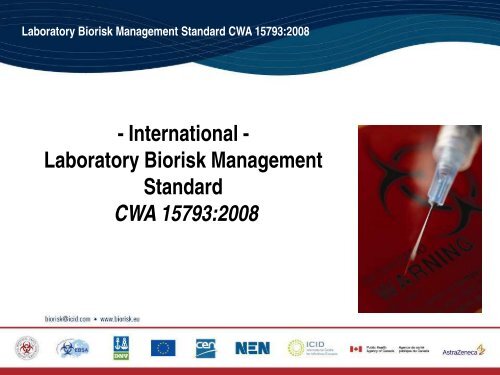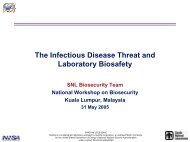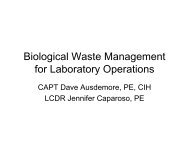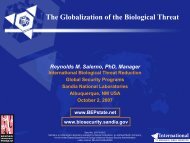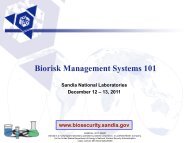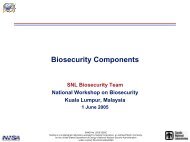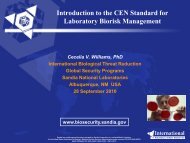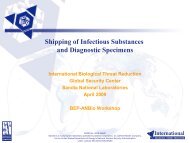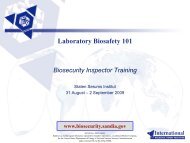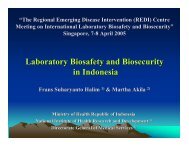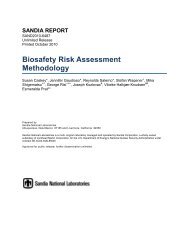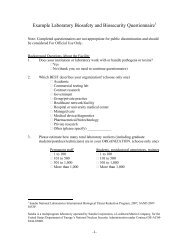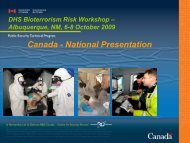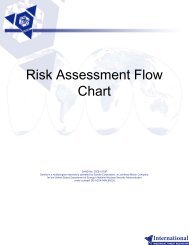Laboratory Biorisk Management Standard CWA 15793:2008
Laboratory Biorisk Management Standard CWA 15793:2008
Laboratory Biorisk Management Standard CWA 15793:2008
- No tags were found...
Create successful ePaper yourself
Turn your PDF publications into a flip-book with our unique Google optimized e-Paper software.
<strong>Laboratory</strong> <strong>Biorisk</strong> <strong>Management</strong> <strong>Standard</strong> <strong>CWA</strong> <strong>15793</strong>:<strong>2008</strong>- International -<strong>Laboratory</strong> <strong>Biorisk</strong> <strong>Management</strong><strong>Standard</strong><strong>CWA</strong> <strong>15793</strong>:<strong>2008</strong>
<strong>Laboratory</strong> <strong>Biorisk</strong> <strong>Management</strong> <strong>Standard</strong> <strong>CWA</strong> <strong>15793</strong>2
<strong>Laboratory</strong> <strong>Biorisk</strong> <strong>Management</strong> <strong>Standard</strong> <strong>CWA</strong> <strong>15793</strong>:<strong>2008</strong>Overview• In 2007, the document was adopted, and publishedas <strong>CWA</strong> <strong>15793</strong>:<strong>2008</strong> by CEN in <strong>2008</strong>– 76 participants from 24 countries developed amanagement system approach to biosafety andbiosecurity in the laboratory– CEN in Brussels facilitated the process with funding bythe European Commission
<strong>Laboratory</strong> <strong>Biorisk</strong> <strong>Management</strong> <strong>Standard</strong> <strong>CWA</strong> <strong>15793</strong>:<strong>2008</strong><strong>CWA</strong> <strong>15793</strong>:<strong>2008</strong>is a<strong>Management</strong> System <strong>Standard</strong>Consistent with other internationalstandards such as ISO 9001 /14001 and OSHAS18001Contains definitions, requirementsand notes for guidance
<strong>Laboratory</strong> <strong>Biorisk</strong> <strong>Management</strong> <strong>Standard</strong> <strong>CWA</strong> <strong>15793</strong>:<strong>2008</strong>A <strong>Management</strong> System ApproachWhat is a <strong>Management</strong> System?• A framework that integrates best practices and procedures• Ensures that an organization can effectively achieve all of its objectives• Frequently built around the Plan, Do, Check, Act cycle
<strong>Laboratory</strong> <strong>Biorisk</strong> <strong>Management</strong> <strong>Standard</strong> <strong>CWA</strong> <strong>15793</strong>:<strong>2008</strong>What is <strong>Biorisk</strong> <strong>Management</strong>?• <strong>Biorisk</strong> encompasses biosafety andbiosecurity, where the hazards arebiological agents and their products• Establishes systems and policies tomanage the laboratory biorisk• Integral in the day-to-day operations of theinstitute / organization, both in normal timesand times of emergency
<strong>Laboratory</strong> <strong>Biorisk</strong> <strong>Management</strong> <strong>Standard</strong> <strong>CWA</strong> <strong>15793</strong>:<strong>2008</strong>Purpose of the <strong>CWA</strong> <strong>15793</strong>:<strong>2008</strong>The <strong>Standard</strong> can be used for:• Improving overall laboratory biorisk performance• Increasing awareness of biosafety andbiosecurity risks• Effective management of complex laboratorysafety and security processes• Improving international laboratory collaborationand safety harmonization• Basis for new or revised legislation or regulations• Support laboratory certification/accreditation,audits/inspections
<strong>Laboratory</strong> <strong>Biorisk</strong> <strong>Management</strong> <strong>Standard</strong> <strong>CWA</strong> <strong>15793</strong>:<strong>2008</strong>Scope• The <strong>Standard</strong> is not a technical document• The <strong>Standard</strong> is performance oriented― Describes what needs to be achieved― How to do it is up to the organization
<strong>Laboratory</strong> <strong>Biorisk</strong> <strong>Management</strong> <strong>Standard</strong> <strong>CWA</strong> <strong>15793</strong>:<strong>2008</strong>Scope• The <strong>Standard</strong> is not intended to replace anynational or sub-national regulatoryrequirements that may apply to thelaboratory/facility• Compliance with regulatory requirements ismandatory
<strong>Laboratory</strong> <strong>Biorisk</strong> <strong>Management</strong> <strong>Standard</strong> <strong>CWA</strong> <strong>15793</strong>:<strong>2008</strong>Integration• The standard is designed to complement othermanagement standards– ISO9001 (Quality)– ISO14001 (Environmental)– OHSAS18001 (Occupational Health and Safety)
<strong>Laboratory</strong> <strong>Biorisk</strong> <strong>Management</strong> <strong>Standard</strong> <strong>CWA</strong> <strong>15793</strong>:<strong>2008</strong><strong>CWA</strong> <strong>15793</strong>:<strong>2008</strong>• Extensive Definition SectionContent• Policy, Planning, Implementation &Operation, Checking and Corrective Action,Review
<strong>Laboratory</strong> <strong>Biorisk</strong> <strong>Management</strong> <strong>Standard</strong> <strong>CWA</strong> <strong>15793</strong>:<strong>2008</strong>ContentExamples of topics covered:– <strong>Biorisk</strong> <strong>Management</strong> Policy– Hazard Identification, risk assessment, and risk control– Roles, responsibilities, and authorities– Training, awareness and competence– Operational control– Emergency response and contingency plans– Inventory monitoring and control– Accident and incident investigation– Inspection and audit– <strong>Biorisk</strong> management review
<strong>Laboratory</strong> <strong>Biorisk</strong> <strong>Management</strong> <strong>Standard</strong> <strong>CWA</strong> <strong>15793</strong>:<strong>2008</strong>International ApproachLocal solutions for local problems• Not country specific• Based on international, acceptable best practices• Local solutions possible• The <strong>Standard</strong> is based around the current WHOBiosafety and Biosecurity Guidelines
<strong>Laboratory</strong> <strong>Biorisk</strong> <strong>Management</strong> <strong>Standard</strong> <strong>CWA</strong> <strong>15793</strong>:<strong>2008</strong>Risk Assessmenthttp://www.biosafetyriskassessment.org/
<strong>Laboratory</strong> <strong>Biorisk</strong> <strong>Management</strong> <strong>Standard</strong> <strong>CWA</strong> <strong>15793</strong>:<strong>2008</strong>Example• Occupational Health4.4.1.6 Occupational healthThe organization shall have access to appropriate occupational health expertise andestablish an occupational health program commensurate with the activities and risk ofthe facility.
<strong>Laboratory</strong> <strong>Biorisk</strong> <strong>Management</strong> <strong>Standard</strong> <strong>CWA</strong> <strong>15793</strong>:<strong>2008</strong><strong>CWA</strong> <strong>15793</strong>BMBL, LBM etc.<strong>Management</strong> System yes noPolicy yes Generic (if at all)ContinualImprovementRoles &ResponsibilitiesyesyesnosomeDocument Control yes noAuditing yes someObjectives yes noCertification(accredited)yesKey differencesno
<strong>Laboratory</strong> <strong>Biorisk</strong> <strong>Management</strong> <strong>Standard</strong> <strong>CWA</strong> <strong>15793</strong>:<strong>2008</strong>Summary<strong>CWA</strong> <strong>15793</strong>:<strong>2008</strong>• Comprehensive blueprint for biosafety &biosecurity (biorisk) program
<strong>Laboratory</strong> <strong>Biorisk</strong> <strong>Management</strong> <strong>Standard</strong> <strong>CWA</strong> <strong>15793</strong>:<strong>2008</strong>• <strong>CWA</strong> <strong>15793</strong>:<strong>2008</strong> has a life-cycle of 3 years– Renewal, change, termination• Learning experience for the community– Implementation by laboratoriesNext Steps
<strong>Laboratory</strong> <strong>Biorisk</strong> <strong>Management</strong> <strong>Standard</strong> <strong>CWA</strong> <strong>15793</strong>:<strong>2008</strong>Next Steps…• Document now available on CEN website• New 2010 CEN workshop:“Guidance Document”• Clearinghouse for user experiences• Training and education seminars and workshopshttp://www.cen.eu/cenorm/businessdomains/technicalcommitteesworkshops/workshops/ws31.asp
<strong>Laboratory</strong> <strong>Biorisk</strong> <strong>Management</strong> <strong>Standard</strong> <strong>CWA</strong> <strong>15793</strong>:<strong>2008</strong>• <strong>CWA</strong> <strong>15793</strong>:<strong>2008</strong> “Guidance Document”1. Meeting in Europe2. Meeting in Africa3. Meeting in North America
<strong>Laboratory</strong> <strong>Biorisk</strong> <strong>Management</strong> <strong>Standard</strong> <strong>CWA</strong> <strong>15793</strong>:<strong>2008</strong>Conclusions• The <strong>Laboratory</strong> <strong>Biorisk</strong> <strong>Management</strong> <strong>Standard</strong> hasbeen developed by the community for thecommunity• Addresses biorisk holistically, and is directlyapplicable for controlling hazardous biologicalagents and toxins in the laboratory
<strong>Laboratory</strong> <strong>Biorisk</strong> <strong>Management</strong> <strong>Standard</strong> <strong>CWA</strong> <strong>15793</strong>:<strong>2008</strong>Conclusions…• Adoption and implementation of the <strong>CWA</strong> <strong>15793</strong>:<strong>2008</strong> willbe an integral part of the future biorisk managementagenda for laboratories worldwide, and a necessity toprotect people and the environment as well as buildingcommunity confidence
<strong>Laboratory</strong> <strong>Biorisk</strong> <strong>Management</strong> <strong>Standard</strong> <strong>CWA</strong> <strong>15793</strong>:<strong>2008</strong>http://www.cen.eu/CENORM/Sectors/technicalcommitteesworkshops/workshops/ws31.asp
<strong>Laboratory</strong> <strong>Biorisk</strong> <strong>Management</strong> <strong>Standard</strong> <strong>CWA</strong> <strong>15793</strong>:<strong>2008</strong>WORLD HEALTH ORGANIZATION24
<strong>Laboratory</strong> <strong>Biorisk</strong> <strong>Management</strong> <strong>Standard</strong> <strong>CWA</strong> <strong>15793</strong>:<strong>2008</strong>References: Guidelines• <strong>Laboratory</strong> Biosafety Manual, 3 rd Edition– World Health Organization• Biosafety in Microbiological and Biomedical Laboratories, 5 thEdition,– CDC/NIH: extensive recommendations on biosecurity• <strong>Laboratory</strong> Biosafety Guidelines, 3 rd Edition– Public Health Agency Canada• <strong>Biorisk</strong> <strong>Management</strong>: <strong>Laboratory</strong> Biosecurity Guidance– WHO/FAO/OIE joint international biosecurity guidelines• <strong>Laboratory</strong> Biosecurity Handbook– Sandia National Laboratories• Organization for Economic Co-operation and Development(OECD) is establishing biosecurity guidelines


